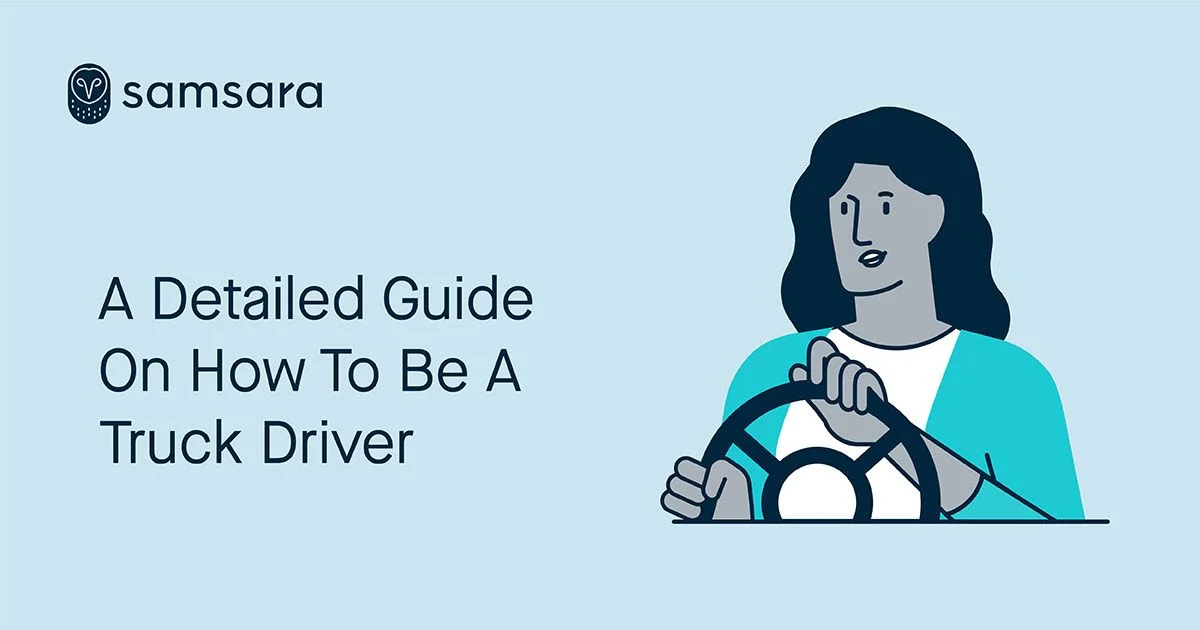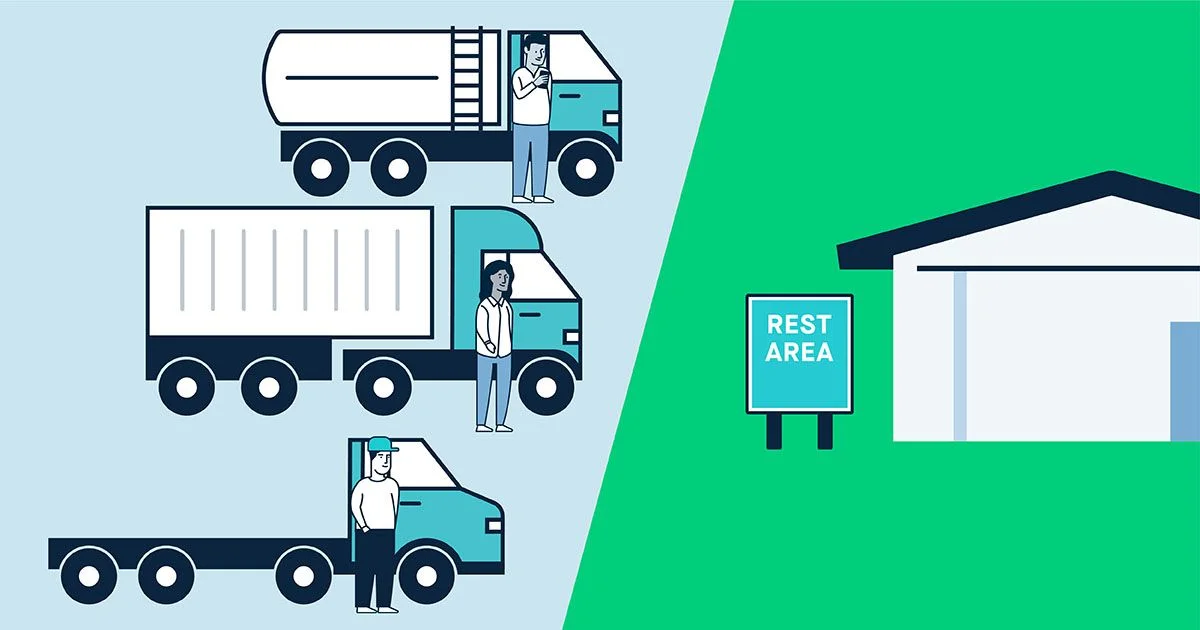A Detailed Guide On How To Become a Truck Driver
July 21, 2020

Get Started with Samsara
Check our pricesKey Takeaways
Starting a job as a truck driver is a rewarding career, however there are several factors that you should consider before pursuing this profession. This article details the requirements for truck drivers, how to become a truck driver, and the different types of truck drivers.
Truck drivers help move goods across our country, whether it’s day or night, a rural or urban setting, or a major highway or city street. These trucks that keep the supply chain flowing require a steady, experienced labor force of drivers to ensure that products get from producers to consumers. Unlike other industries, the demand for qualified and reliable truck drivers is steady. In fact, as the pool of truck drivers continues to get older, the demand for more drivers continues to grow—part of why the industry is currently experiencing a driver shortage.
If you’re thinking about becoming a truck driver, this can be a good time to consider the profession more seriously. Increasing demand for drivers has brought rising wages, better benefits, and the chance for a stable and productive career. But how do you become a truck driver? What do you need to do to meet the hiring and regulatory standards of major trucking companies?
Read on for a guide to help you understand what you need to become a truck driver—from getting your CDL license to following Federal Motor Carrier Safety Administration (FMCSA) regulations.
4 requirements for all truck drivers
If you’re thinking about becoming a truck driver, you’re probably curious what the requirements are. There are a few common industry-wide requirements you’ll need in order to qualify and become a strong candidate for this career choice. These include:
1. High school or GED diploma
While most companies do not require a college degree, the industry expects drivers to have a minimum level of education. Some companies may want additional education requirements—such as enrollment at a vocational school or a community college program—but a high school degree will satisfy most employer requirements. You will also need to attend truck driving school before beginning your work, but more on that later.
2. Age requirement
The trucking industry requires a minimum age of 18 for drivers who will travel within a specific region or state. The minimum age for drivers traveling across the country or borders into Mexico or Canada is 21.
3. Clean driving record
Beyond education, you will also require a clean and safe driving record. While a minor accident or speeding ticket will not prevent you from truck driving, greater citations may be difficult to overcome. For instance, driving while intoxicated (DUI) or operating while intoxicated (OWI) citations are a disqualifier. Additionally, if you’ve been in serious accidents or have a pattern of reckless driving tickets and court appearances, you will also be ineligible.
4. Physical fitness and health requirements
Federal trucking regulations require truck drivers to be physically and mentally able to perform the duties and demands of the job. In most truck driving jobs, candidates must have excellent vision and hearing, hand-eye coordination, and strong physical health. Driver must also have a minimum 20/40 vision and a 70-degree field of vision in each eye. Truck driving schools will test for these requirements through a mandatory physical exam before you can enroll or seek employment in the industry.
How do you become a truck driver?
If you meet the minimum requirements for employment, the next step is to begin vocational training. Becoming a truck driver requires more training than simply knowing how to drive safely. You must become familiar with commercial trucking, different vehicles, and cargo types. Below are a list of tasks you’ll need to complete to do the job safely and successfully:
Enroll in a trucking school program or CDL training to prepare for your state’s commercial driver’s license (CDL) exam
Schedule and complete your state CDL exam
Find a position at a trucking company
Complete one to three months of on-the-job-training
Here’s a closer look at what you should do to prepare and complete each step.
What is trucking school and what will you learn in trucking school?
Trucking schools teach you how to operate different commercial trucks and the equipment associated with them, such as refrigerated holds and lifts. Trucking schools also teach the important safety regulations and procedures required by federal, state, and local regulations. Schools often focus on the content required by state CDL exams.
Trucking schools also offer classes that let you add trucking endorsements to your eventual license. Endorsements are extra permissions added to your CDL. They’re key for operating more hazardous or specialized vehicles, like semi-trucks, school vehicles, tanker trucks, or trucks hauling hazardous materials.
So where do you attend trucking school? Many community colleges and various private programs offer trucking education programs, all geared toward teaching you the content needed to pass state and federal licensing exams. This includes both classroom work, as well as hands-on operations work—typically on a driving range designed to practice every aspect of operating an actual rig. Depending on the school, these programs may take anywhere from several weeks to many months to complete.
But you’re not finished with your trucking program once you receive your license. Most trucking companies will also require you to complete one to three months of on-the-job training. During this period, you’ll apply what you learned to companies that exist specifically to comply with regulations and safety standards. For example, many trucking companies will have new drivers apprentice with more seasoned professional truck drivers on regular runs to experience the typical operational routine. Additionally, trucking companies will often begin entry-level or first- year truckers with easier assignments to allow new drivers more practice before moving on to more demanding jobs.
<div class="text-center"><a id="blog-inline-1" href="/learn-more" title="Learn more about Samsara" class="btn primary-btn teal btn--blue">Learn more about Samsara</a></div>
How do you pick the right truck driving school?
Once you decide to enroll in a truck driving school, the number of choices may overwhelm you. To help sort out which trucking school is right for you, here are some key factors to consider:
Is the school accredited and licensed? Do some research to learn who accredited and licensed the program and how long that school has had those certifications
Are there job placement and internship services? It might be in your best interest to select a school that provides an employment placement service, otherwise you will be required to secure your own employment opportunities after graduating.
What courses do they offer? Depending on the type of trucking you’re interested in, consider if the school offers basic requirements for a commercial driver’s license (CDL) or if there’s more diversified courses.
Does the school offer classes in-person or online? If the program is online, you might want to check what types of opportunities there are for behind-the-wheel experience.
How much does the school cost? Trucking school tuition varies significantly based on the program’s length and content. Potential extra offerings like job placement can also cost more. While many programs cost between $3,000-5,000, confirm that the cost of attendance covers everything from the CDL exam to licensing. Otherwise, you may get stuck paying additional fees later.
Does the program offer financial aid? Check if there are options to help offset costs.
Are there sponsorship opportunities with trucking companies? If you have already networked and found a trucking company looking for prospects, see if it will help pay for trucking school. Many companies offer tuition reimbursement or coverage to meet increasing driver demand.
What are the different types of trucking licenses?
Beyond the main commercial driver’s license, there are additional license classes you may need for different types of trucking work:
Class A License: This license allows drivers to operate vehicles that carry over 26,001 pounds of cargo or weight.
Class B License: This license allows drivers to operate vehicles with a maximum of 26,000 pounds.
Class C License: This license permits you to carry hazardous materials and/or driving large passenger trucks.
The Class C license also includes different endorsements, including “H” for hazardous materials, “N” for tanker trucks., and “X” for both. The more endorsements you can add to your certification, the wider the employment opportunities available to you.

What are the different kinds of truck drivers?
While many people often think of tractor-trailers (or eighteen-wheelers) when they think of truck driving, there is actually a much wider array of different trucking specialties. These include:
Dry van drivers
This is often the starting point for new or apprentice long-haul truck drivers. Dry van drivers transport single trailer vehicles usually loaded with non-perishable or dry goods items. These jobs rarely involve the driver unloading goods themselves.
Flatbed drivers
Since flatbeds involve securing goods to the bed of a truck (specific to what you haul), flatbed drivers are usually more experienced and better compensated.
Tanker drivers
These drivers are often in high demand. They require a specific endorsement because of the risk involved in their work. Tanker drivers often transport hazardous materials and as a result must have more experience and meet stricter safety standards.
Freight haulers or less than truckload freight drivers
Freight haulers transport any goods not covered under the “dry van” category, meaning liquids, hazardous goods, and oversized loads. Meanwhile, less than truckload (LTL) freight drivers do the same, but transport smaller shipments over shorter distances and often with multiple truck stops during the day.
Team drivers
Some companies and rig owners opt to employ a “team” of drivers (usually a partnership). This helps keep rigs on the road longer as drivers trade-off to ensure driver safety and health. Because more jobs can be completed and less downtime is needed, team drivers can make significantly more money if the partnership works well together.
How truck drivers benefit from fleet management solutions
Advancements in telematics technology have helped simplify some of the responsibilities that truck drivers take on. Fleet management solutions, like those available from Samsara, have streamlined many aspects of working in the industry.
For example, Samsara’s driver safety and coaching software improves on-the-job training to allow for real-time communication and interaction between fleet managers and new drivers.
Driver compliance, as mandated by the FMCSA, is also simplified with fleet management technology. Hours of Service (HOS) duty statuses, including personal conveyance, are easy to manage with Samsara’s ELD solution and Vehicle Gateways (VGs). Samsara’s ELD platform serves as an integrated solution to ensure compliance and improve efficiency across your operations. Our complete platform automatically and accurately tracks HOS and surfaces any unassigned hours in our Compliance Dashboard, making it easy to take the necessary steps to both avoid violations and prepare for audits should they arise.
The Samsara ELD solution also connects with the Driver App, making it easy for drivers to quickly complete pre-trip and post- trip inspections, set their duty status, and review and certify their HOS logs. Samsara combines input from our Driver App and GPS and engine data from our VGs to automatically create drive time segments and set statuses when a vehicle is turned on, in motion, or turned off.
To learn more about how Samsara can help create a more seamless experience for drivers, schedule a demo or free trial today.
<div class="text-center"><a id="blog-inline-1" href="/learn-more" title="Learn more about Samsara" class="btn primary-btn teal btn--blue">Learn more about Samsara</a></div>